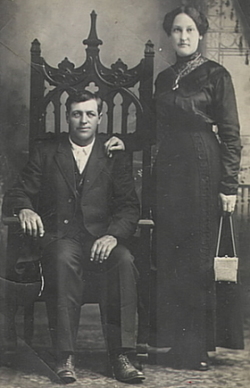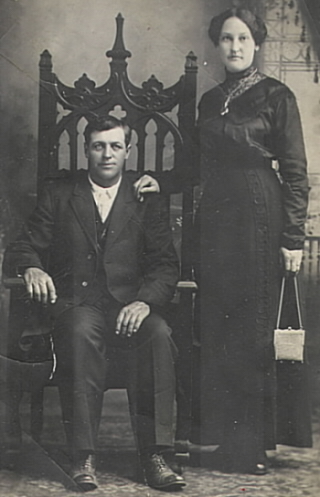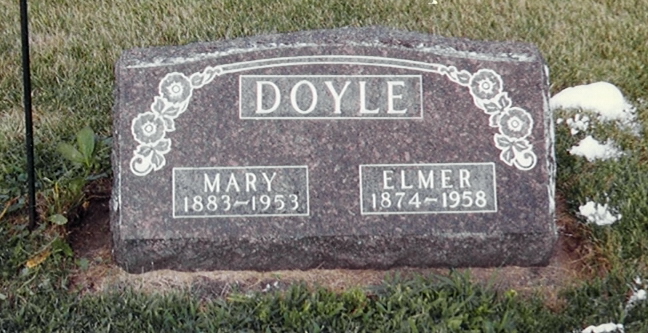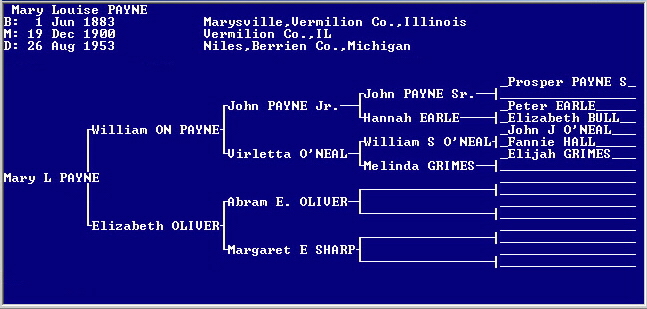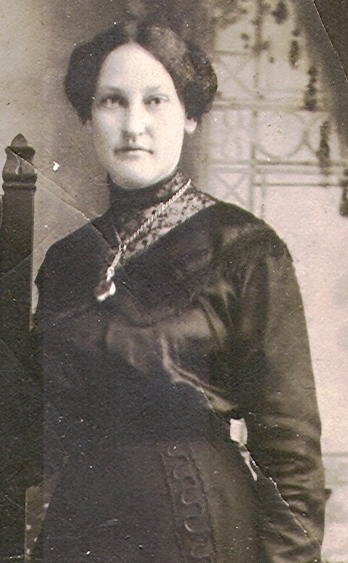Mary was a farmer's wife who survived the farmers' depression of the 1920s and the Great Depression of the 1930s. She was born in rural Vermilion County, Illinois, to the local butcher and his wife.
Before she was five years old, her father died. Before she was six years old, her mother had married her divorced uncle. Indeed, the uncle divorced his 1st wife and married Mary's mother two days after the divorce. In a little town, it's likely that the gossips had a field day with that situation. Suddenly, Mary's uncle was her stepfather, and Mary's paternal cousin was her stepbrother. And the ex-wife of her paternal uncle/stepfather was still in the little town.
Mary had a 6th grade education and married when she was 17-and-a-half years old. Her first child was born 16 months later, and she birthed another two children quickly after the first. There was a nine-year gap between her 3rd child and her 4th child, and then her 5th child was born soon after the 4th. Thus, in many ways, she had two sets of children -- all by the same father, but spaced apart by the years and by the different experiences of those years.
Shortly before 1920, Mary and her husband moved to Lockhart Township, Norman County, Minnesota. The plan was to raise potatoes because potatoes were selling at a high price.
When they moved to Minnesota, they had two train cars filled with their possessions -- one filled with household goods, the other with farm animals. They had themselves, and three children (the oldest had married and stayed behind in Vermilion County, Illinois), and they had visions of getting rich because the price of potatoes had risen and because Mary's husband was a skilled farmer.
But Mary's husband had no understanding of economics.
Because the price of potatoes had risen so high, too many farmers were growing potatoes. When Mary's husband tried to sell his crop, he could not have given the potatoes away; the market was flooded. Throughout the United States, farm prices plunged in the summer of 1920 and remained low for the rest of the decade -- the "farmers depression." In 1919, potatoes sold for $2.20 per hundredweight; in 1929, potatoes sold for $1.29 per hundredweight.
When Mary and her husband left Minnesota, they left with the clothes on their backs, debts beyond what they could ever repay, and one more child -- a baby girl born after the crash in the potato market. Mary was 37 when her last child was born.
Before Mary was 47, the family had moved to Berrien County, Michigan, where they survived for a few years of the Great Depression. Before she was 57, the family had returned to Vermilion County, Illinois.
And it was in Vermilion County where she delivered two of her grandbabies -- twin girls born to her son Ralph's wife. The son had fetched a physician to attend to the births. When the doctor arrived, it was late, and he was tired. He knew that Mary had assisted at births before, and he told Mary, "You take the first. Wake me up, and I'll deliver the second." The doctor expected the first birth to be easy, and the second birth to be delayed. Instead, the births were fast enough that Mary midwifed both of her granddaughters into the world. The doctor later gave a bill to Mary's son, for his professional services. Mary's son told the doctor, "I'm not paying you. My mother delivered both of those babies!"
Before Mary was 60, she was again living in Berrien County, Michigan, with most of her children and grandchildren living nearby. She was poor, but she had a growing number of grandchildren, some of whom she cared for at different times.
In Berrien County, she had a few goats, and she had a window full of begonias that she would keep blooming all year 'round, and she had her singing canaries that she would raise from hatchlings. She would get around in the rural area with her husband driving a big black model B Ford, with the throttle on the steering wheel.
She died when she was 70. She'd had diabetes and heart disease, and she had gangrene in one foot. In her last months as she was too sick to care for herself, the wife of her grandson Garold provided her care. When she died, it was the wife of another grandson (Elmer's wife, Beverly) who sat with her until she died.
Mary was a farmer's wife who survived the farmers' depression of the 1920s and the Great Depression of the 1930s. She was born in rural Vermilion County, Illinois, to the local butcher and his wife.
Before she was five years old, her father died. Before she was six years old, her mother had married her divorced uncle. Indeed, the uncle divorced his 1st wife and married Mary's mother two days after the divorce. In a little town, it's likely that the gossips had a field day with that situation. Suddenly, Mary's uncle was her stepfather, and Mary's paternal cousin was her stepbrother. And the ex-wife of her paternal uncle/stepfather was still in the little town.
Mary had a 6th grade education and married when she was 17-and-a-half years old. Her first child was born 16 months later, and she birthed another two children quickly after the first. There was a nine-year gap between her 3rd child and her 4th child, and then her 5th child was born soon after the 4th. Thus, in many ways, she had two sets of children -- all by the same father, but spaced apart by the years and by the different experiences of those years.
Shortly before 1920, Mary and her husband moved to Lockhart Township, Norman County, Minnesota. The plan was to raise potatoes because potatoes were selling at a high price.
When they moved to Minnesota, they had two train cars filled with their possessions -- one filled with household goods, the other with farm animals. They had themselves, and three children (the oldest had married and stayed behind in Vermilion County, Illinois), and they had visions of getting rich because the price of potatoes had risen and because Mary's husband was a skilled farmer.
But Mary's husband had no understanding of economics.
Because the price of potatoes had risen so high, too many farmers were growing potatoes. When Mary's husband tried to sell his crop, he could not have given the potatoes away; the market was flooded. Throughout the United States, farm prices plunged in the summer of 1920 and remained low for the rest of the decade -- the "farmers depression." In 1919, potatoes sold for $2.20 per hundredweight; in 1929, potatoes sold for $1.29 per hundredweight.
When Mary and her husband left Minnesota, they left with the clothes on their backs, debts beyond what they could ever repay, and one more child -- a baby girl born after the crash in the potato market. Mary was 37 when her last child was born.
Before Mary was 47, the family had moved to Berrien County, Michigan, where they survived for a few years of the Great Depression. Before she was 57, the family had returned to Vermilion County, Illinois.
And it was in Vermilion County where she delivered two of her grandbabies -- twin girls born to her son Ralph's wife. The son had fetched a physician to attend to the births. When the doctor arrived, it was late, and he was tired. He knew that Mary had assisted at births before, and he told Mary, "You take the first. Wake me up, and I'll deliver the second." The doctor expected the first birth to be easy, and the second birth to be delayed. Instead, the births were fast enough that Mary midwifed both of her granddaughters into the world. The doctor later gave a bill to Mary's son, for his professional services. Mary's son told the doctor, "I'm not paying you. My mother delivered both of those babies!"
Before Mary was 60, she was again living in Berrien County, Michigan, with most of her children and grandchildren living nearby. She was poor, but she had a growing number of grandchildren, some of whom she cared for at different times.
In Berrien County, she had a few goats, and she had a window full of begonias that she would keep blooming all year 'round, and she had her singing canaries that she would raise from hatchlings. She would get around in the rural area with her husband driving a big black model B Ford, with the throttle on the steering wheel.
She died when she was 70. She'd had diabetes and heart disease, and she had gangrene in one foot. In her last months as she was too sick to care for herself, the wife of her grandson Garold provided her care. When she died, it was the wife of another grandson (Elmer's wife, Beverly) who sat with her until she died.
Gravesite Details
grandmother of page creator
